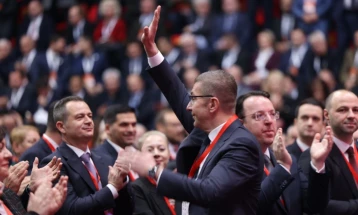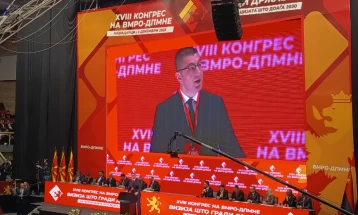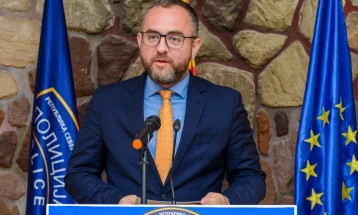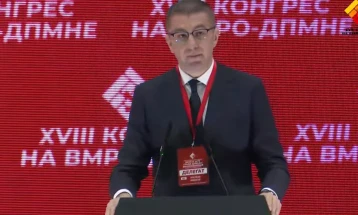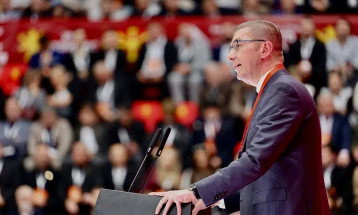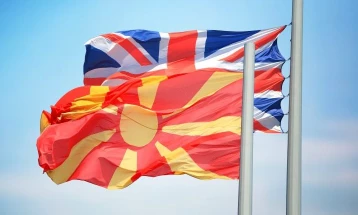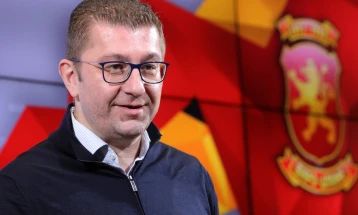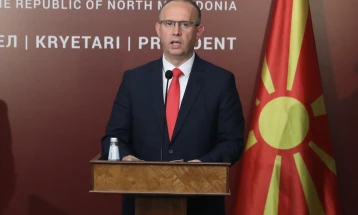Pandemic did not stop movement of refugees, they can contribute to country’s development if there is solidarity, Sandri tells MIA
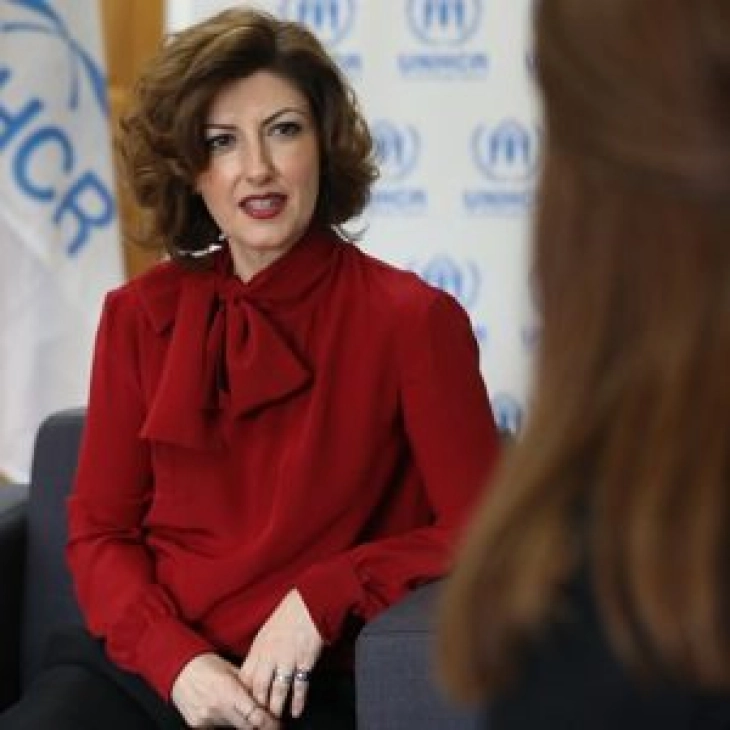
Skopje, 20 June 2021 (MIA) – Once a person with his or her children is at risk of being killed or persecuted, there are no walls or pandemics that can dissuade them from trying to find safety. The pandemic did not stop the movement and neither did the restrictions, says UNHCR Representative in North Macedonia, Monica Sandri, in an interview with MIA.
Speaking on World Refugee Day, Sandri says there has been an increase in the number of people forced to flee their homes.
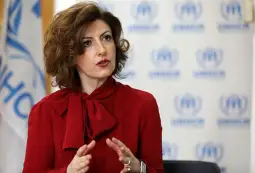 The Balkan migration route has been officially closed in accordance with the agreement between Brussels and Turkey in 2016. However, in reality, movement hasn’t stopped. What is the situation like in the region and in the country in terms of refugees, especially taking into consideration the pandemic and the closed borders?
Movement has not stopped because wars, conflict, persecution and human rights violations have not stopped in the world. According to the UNHCR Global Trends report, there has been a 4% increase in the number of people forced to flee their homes, raising the total from 79.5 million at the end of 2019 to 82.4 million people at the end of 2020.
Once a person with his or her children is at risk of being killed or persecuted, there are no walls or pandemics that can dissuade them from trying to find safety. The pandemic did not stop the movement and neither did the restrictions, including 99 states keeping their borders closed even for people seeking asylum.
In North Macedonia, the authorities rapidly put in place measures like medical screenings, temporary quarantine upon arrival, and remote interviewing, and as a result the people who needed protection were still allowed to apply for asylum.
How many requests for asylum have there been since the beginning of the COVID-19 crisis?
All throughout last year, there were 211 asylum applications, whereas that number for this year so far (until the end of May) has been 25.
How many have been granted, and how many rejected?
During 2020, there were two positive decisions, while this year, no positive decisions have been reached yet.
The Balkan migration route has been officially closed in accordance with the agreement between Brussels and Turkey in 2016. However, in reality, movement hasn’t stopped. What is the situation like in the region and in the country in terms of refugees, especially taking into consideration the pandemic and the closed borders?
Movement has not stopped because wars, conflict, persecution and human rights violations have not stopped in the world. According to the UNHCR Global Trends report, there has been a 4% increase in the number of people forced to flee their homes, raising the total from 79.5 million at the end of 2019 to 82.4 million people at the end of 2020.
Once a person with his or her children is at risk of being killed or persecuted, there are no walls or pandemics that can dissuade them from trying to find safety. The pandemic did not stop the movement and neither did the restrictions, including 99 states keeping their borders closed even for people seeking asylum.
In North Macedonia, the authorities rapidly put in place measures like medical screenings, temporary quarantine upon arrival, and remote interviewing, and as a result the people who needed protection were still allowed to apply for asylum.
How many requests for asylum have there been since the beginning of the COVID-19 crisis?
All throughout last year, there were 211 asylum applications, whereas that number for this year so far (until the end of May) has been 25.
How many have been granted, and how many rejected?
During 2020, there were two positive decisions, while this year, no positive decisions have been reached yet.
 Which countries do asylum seekers come from?
Globally, 68% of all people who fled abroad came from just five countries: Syria (6.7 million), Venezuela (4.0 million), Afghanistan (2.6 million), South Sudan (2.2 million) and Myanmar (1.1 million). This means that stopping persecution, human rights violations and war in only five countries would dramatically decrease the number of displaced in the world.
Can you list some of your activities foreseen for this year in terms of inclusion of refugees into our society?
First and foremost, we want to show people here that refugees and asylum seekers can bring a positive contribution to the sustainable development of the country if there is solidarity and the system allows it. Refugees are people like you and me, they used to have jobs, they have education, skills, and talents that can be of benefit to any society.
To enable the inclusion of refugees, UNHCR works to support the country in improving the quality of asylum, building a protection sensitive entry system, eradicating statelessness, improving the legal framework and its implementation, as well as strengthening preparedness and response to avert crises.
Which countries do asylum seekers come from?
Globally, 68% of all people who fled abroad came from just five countries: Syria (6.7 million), Venezuela (4.0 million), Afghanistan (2.6 million), South Sudan (2.2 million) and Myanmar (1.1 million). This means that stopping persecution, human rights violations and war in only five countries would dramatically decrease the number of displaced in the world.
Can you list some of your activities foreseen for this year in terms of inclusion of refugees into our society?
First and foremost, we want to show people here that refugees and asylum seekers can bring a positive contribution to the sustainable development of the country if there is solidarity and the system allows it. Refugees are people like you and me, they used to have jobs, they have education, skills, and talents that can be of benefit to any society.
To enable the inclusion of refugees, UNHCR works to support the country in improving the quality of asylum, building a protection sensitive entry system, eradicating statelessness, improving the legal framework and its implementation, as well as strengthening preparedness and response to avert crises.
 UNHCR in collaboration with the Ministry of Labour and Social Policy has created a platform for learning Macedonian for refugees. Is this platform already functional?
Indeed, we developed a digital platform for learning Macedonian Language, in coordination with the Faculty of Philology and the Ministry of Labour and Social Policy. The platform, developed with funds from the European Union, is fully functional now and we are just starting to roll it out. It is the first of its kind and offers free online language classes for asylum seekers and refugees to ease their inclusion. This platform will be managed by the Faculty of Philology Blazhe Koneski and can be also made accessible to other foreigners who want to learn Macedonian.
In the local school in Skopje, there are also refugee children who receive education. What is the method of education for these children?
The three refugee children in the elementary school receive education online, just like their classmates. At the beginning of the COVID-19 epidemic, we reached out to both the Vizbegovo Centre for Asylum Seekers and the local primary school, and with funds from the United States of America and the support from our partner the City Red Cross of Skopje, we provided tablets to the children so that they could be in contact with their teacher and continue to attend classes and do their homework. We also provided the teacher with a laptop to stay in touch with all her students, including the local children with whom the refugee children study.
UNHCR in collaboration with the Ministry of Labour and Social Policy has created a platform for learning Macedonian for refugees. Is this platform already functional?
Indeed, we developed a digital platform for learning Macedonian Language, in coordination with the Faculty of Philology and the Ministry of Labour and Social Policy. The platform, developed with funds from the European Union, is fully functional now and we are just starting to roll it out. It is the first of its kind and offers free online language classes for asylum seekers and refugees to ease their inclusion. This platform will be managed by the Faculty of Philology Blazhe Koneski and can be also made accessible to other foreigners who want to learn Macedonian.
In the local school in Skopje, there are also refugee children who receive education. What is the method of education for these children?
The three refugee children in the elementary school receive education online, just like their classmates. At the beginning of the COVID-19 epidemic, we reached out to both the Vizbegovo Centre for Asylum Seekers and the local primary school, and with funds from the United States of America and the support from our partner the City Red Cross of Skopje, we provided tablets to the children so that they could be in contact with their teacher and continue to attend classes and do their homework. We also provided the teacher with a laptop to stay in touch with all her students, including the local children with whom the refugee children study.
 There is a state Reception centre for asylum seekers in Skopje which has accommodation capacity for up to 150 persons. What are the living conditions in the centre and how many people are there at the moment?
Presently there are 22 asylum seekers accommodated in the Vizbegovo Centre for Asylum Seekers. We are in constant contact with both the asylum seekers and the management of the Centre and we work together to address the needs of the persons accommodated there. The Centre offers all the services that asylum seekers are entitled to, provided by staff who have extensive experience working with refugees. You may have seen our social media videos of our workshops for Easter and Ramadan. Right now, we are preparing for a table tennis tournament on the occasion of World Refugee Day, which is on 20 June, Sunday.
Where do these persons come from and where do their asylum procedures stand?
Here, the people who have sought asylum come from a variety of countries from different continents, including countries where there is active conflict, but also countries where there is no war or conflict, and yet some groups of people are persecuted because of belonging to a specific group based on their race, religion, nationality, membership of a particular social group, or political opinion. Asylum procedures are done at the individual level, so each of them is at a different stage.
There is a state Reception centre for asylum seekers in Skopje which has accommodation capacity for up to 150 persons. What are the living conditions in the centre and how many people are there at the moment?
Presently there are 22 asylum seekers accommodated in the Vizbegovo Centre for Asylum Seekers. We are in constant contact with both the asylum seekers and the management of the Centre and we work together to address the needs of the persons accommodated there. The Centre offers all the services that asylum seekers are entitled to, provided by staff who have extensive experience working with refugees. You may have seen our social media videos of our workshops for Easter and Ramadan. Right now, we are preparing for a table tennis tournament on the occasion of World Refugee Day, which is on 20 June, Sunday.
Where do these persons come from and where do their asylum procedures stand?
Here, the people who have sought asylum come from a variety of countries from different continents, including countries where there is active conflict, but also countries where there is no war or conflict, and yet some groups of people are persecuted because of belonging to a specific group based on their race, religion, nationality, membership of a particular social group, or political opinion. Asylum procedures are done at the individual level, so each of them is at a different stage.
 According to our laws, 9 months after submitting an asylum request, the person has the opportunity to work. How many persons have so far realized this right?
Unfortunately, due to administrative barriers, this is one of the rights that asylum seekers still cannot exercise. Providing the opportunity for asylum seekers to work would not only improve their mental health and personal (family) situation, but it would also allow them to contribute to the development of the community. Sustainable development can be achieved only if no one is left behind.
According to our laws, 9 months after submitting an asylum request, the person has the opportunity to work. How many persons have so far realized this right?
Unfortunately, due to administrative barriers, this is one of the rights that asylum seekers still cannot exercise. Providing the opportunity for asylum seekers to work would not only improve their mental health and personal (family) situation, but it would also allow them to contribute to the development of the community. Sustainable development can be achieved only if no one is left behind.
 In what way do refugees receive health protection in the country, especially now during the pandemic?
At the Vizbegovo Centre for Asylum Seekers, there is a medical team for primary health services. If there is a need, the doctor refers the asylum seekers to secondary health facilities. The same goes for Vinojug Reception and Transit Centre, where refugees who need medical assistance are referred to the Gevgelija hospital. At these centres, with European Union funds, we provided nearly 15 tonnes of liquid disinfectant, hand dispensers, plexiglass protective boards, food items, furniture, footwear, bedding and linen, sanitary gates for persons, a sanitary tunnel for vehicles, and additional containers for persons with specific needs.
Additionally, last December, again with the support from the United States of America, UNHCR donated significant quantities of necessary items to the Gevgelija hospital, including linen, pillows, covers, automatic hand sanitizers, plexiglass barriers, computers, etc.
We know very well that no one is safe until everyone is safe, and that COVID-19 doesn’t pick and choose, so we all have to work together to save lives.
Bisera Trajkovska
Photo: Darko Popov
In what way do refugees receive health protection in the country, especially now during the pandemic?
At the Vizbegovo Centre for Asylum Seekers, there is a medical team for primary health services. If there is a need, the doctor refers the asylum seekers to secondary health facilities. The same goes for Vinojug Reception and Transit Centre, where refugees who need medical assistance are referred to the Gevgelija hospital. At these centres, with European Union funds, we provided nearly 15 tonnes of liquid disinfectant, hand dispensers, plexiglass protective boards, food items, furniture, footwear, bedding and linen, sanitary gates for persons, a sanitary tunnel for vehicles, and additional containers for persons with specific needs.
Additionally, last December, again with the support from the United States of America, UNHCR donated significant quantities of necessary items to the Gevgelija hospital, including linen, pillows, covers, automatic hand sanitizers, plexiglass barriers, computers, etc.
We know very well that no one is safe until everyone is safe, and that COVID-19 doesn’t pick and choose, so we all have to work together to save lives.
Bisera Trajkovska
Photo: Darko Popov
 The Balkan migration route has been officially closed in accordance with the agreement between Brussels and Turkey in 2016. However, in reality, movement hasn’t stopped. What is the situation like in the region and in the country in terms of refugees, especially taking into consideration the pandemic and the closed borders?
Movement has not stopped because wars, conflict, persecution and human rights violations have not stopped in the world. According to the UNHCR Global Trends report, there has been a 4% increase in the number of people forced to flee their homes, raising the total from 79.5 million at the end of 2019 to 82.4 million people at the end of 2020.
Once a person with his or her children is at risk of being killed or persecuted, there are no walls or pandemics that can dissuade them from trying to find safety. The pandemic did not stop the movement and neither did the restrictions, including 99 states keeping their borders closed even for people seeking asylum.
In North Macedonia, the authorities rapidly put in place measures like medical screenings, temporary quarantine upon arrival, and remote interviewing, and as a result the people who needed protection were still allowed to apply for asylum.
How many requests for asylum have there been since the beginning of the COVID-19 crisis?
All throughout last year, there were 211 asylum applications, whereas that number for this year so far (until the end of May) has been 25.
How many have been granted, and how many rejected?
During 2020, there were two positive decisions, while this year, no positive decisions have been reached yet.
The Balkan migration route has been officially closed in accordance with the agreement between Brussels and Turkey in 2016. However, in reality, movement hasn’t stopped. What is the situation like in the region and in the country in terms of refugees, especially taking into consideration the pandemic and the closed borders?
Movement has not stopped because wars, conflict, persecution and human rights violations have not stopped in the world. According to the UNHCR Global Trends report, there has been a 4% increase in the number of people forced to flee their homes, raising the total from 79.5 million at the end of 2019 to 82.4 million people at the end of 2020.
Once a person with his or her children is at risk of being killed or persecuted, there are no walls or pandemics that can dissuade them from trying to find safety. The pandemic did not stop the movement and neither did the restrictions, including 99 states keeping their borders closed even for people seeking asylum.
In North Macedonia, the authorities rapidly put in place measures like medical screenings, temporary quarantine upon arrival, and remote interviewing, and as a result the people who needed protection were still allowed to apply for asylum.
How many requests for asylum have there been since the beginning of the COVID-19 crisis?
All throughout last year, there were 211 asylum applications, whereas that number for this year so far (until the end of May) has been 25.
How many have been granted, and how many rejected?
During 2020, there were two positive decisions, while this year, no positive decisions have been reached yet.
 Which countries do asylum seekers come from?
Globally, 68% of all people who fled abroad came from just five countries: Syria (6.7 million), Venezuela (4.0 million), Afghanistan (2.6 million), South Sudan (2.2 million) and Myanmar (1.1 million). This means that stopping persecution, human rights violations and war in only five countries would dramatically decrease the number of displaced in the world.
Can you list some of your activities foreseen for this year in terms of inclusion of refugees into our society?
First and foremost, we want to show people here that refugees and asylum seekers can bring a positive contribution to the sustainable development of the country if there is solidarity and the system allows it. Refugees are people like you and me, they used to have jobs, they have education, skills, and talents that can be of benefit to any society.
To enable the inclusion of refugees, UNHCR works to support the country in improving the quality of asylum, building a protection sensitive entry system, eradicating statelessness, improving the legal framework and its implementation, as well as strengthening preparedness and response to avert crises.
Which countries do asylum seekers come from?
Globally, 68% of all people who fled abroad came from just five countries: Syria (6.7 million), Venezuela (4.0 million), Afghanistan (2.6 million), South Sudan (2.2 million) and Myanmar (1.1 million). This means that stopping persecution, human rights violations and war in only five countries would dramatically decrease the number of displaced in the world.
Can you list some of your activities foreseen for this year in terms of inclusion of refugees into our society?
First and foremost, we want to show people here that refugees and asylum seekers can bring a positive contribution to the sustainable development of the country if there is solidarity and the system allows it. Refugees are people like you and me, they used to have jobs, they have education, skills, and talents that can be of benefit to any society.
To enable the inclusion of refugees, UNHCR works to support the country in improving the quality of asylum, building a protection sensitive entry system, eradicating statelessness, improving the legal framework and its implementation, as well as strengthening preparedness and response to avert crises.
 UNHCR in collaboration with the Ministry of Labour and Social Policy has created a platform for learning Macedonian for refugees. Is this platform already functional?
Indeed, we developed a digital platform for learning Macedonian Language, in coordination with the Faculty of Philology and the Ministry of Labour and Social Policy. The platform, developed with funds from the European Union, is fully functional now and we are just starting to roll it out. It is the first of its kind and offers free online language classes for asylum seekers and refugees to ease their inclusion. This platform will be managed by the Faculty of Philology Blazhe Koneski and can be also made accessible to other foreigners who want to learn Macedonian.
In the local school in Skopje, there are also refugee children who receive education. What is the method of education for these children?
The three refugee children in the elementary school receive education online, just like their classmates. At the beginning of the COVID-19 epidemic, we reached out to both the Vizbegovo Centre for Asylum Seekers and the local primary school, and with funds from the United States of America and the support from our partner the City Red Cross of Skopje, we provided tablets to the children so that they could be in contact with their teacher and continue to attend classes and do their homework. We also provided the teacher with a laptop to stay in touch with all her students, including the local children with whom the refugee children study.
UNHCR in collaboration with the Ministry of Labour and Social Policy has created a platform for learning Macedonian for refugees. Is this platform already functional?
Indeed, we developed a digital platform for learning Macedonian Language, in coordination with the Faculty of Philology and the Ministry of Labour and Social Policy. The platform, developed with funds from the European Union, is fully functional now and we are just starting to roll it out. It is the first of its kind and offers free online language classes for asylum seekers and refugees to ease their inclusion. This platform will be managed by the Faculty of Philology Blazhe Koneski and can be also made accessible to other foreigners who want to learn Macedonian.
In the local school in Skopje, there are also refugee children who receive education. What is the method of education for these children?
The three refugee children in the elementary school receive education online, just like their classmates. At the beginning of the COVID-19 epidemic, we reached out to both the Vizbegovo Centre for Asylum Seekers and the local primary school, and with funds from the United States of America and the support from our partner the City Red Cross of Skopje, we provided tablets to the children so that they could be in contact with their teacher and continue to attend classes and do their homework. We also provided the teacher with a laptop to stay in touch with all her students, including the local children with whom the refugee children study.
 There is a state Reception centre for asylum seekers in Skopje which has accommodation capacity for up to 150 persons. What are the living conditions in the centre and how many people are there at the moment?
Presently there are 22 asylum seekers accommodated in the Vizbegovo Centre for Asylum Seekers. We are in constant contact with both the asylum seekers and the management of the Centre and we work together to address the needs of the persons accommodated there. The Centre offers all the services that asylum seekers are entitled to, provided by staff who have extensive experience working with refugees. You may have seen our social media videos of our workshops for Easter and Ramadan. Right now, we are preparing for a table tennis tournament on the occasion of World Refugee Day, which is on 20 June, Sunday.
Where do these persons come from and where do their asylum procedures stand?
Here, the people who have sought asylum come from a variety of countries from different continents, including countries where there is active conflict, but also countries where there is no war or conflict, and yet some groups of people are persecuted because of belonging to a specific group based on their race, religion, nationality, membership of a particular social group, or political opinion. Asylum procedures are done at the individual level, so each of them is at a different stage.
There is a state Reception centre for asylum seekers in Skopje which has accommodation capacity for up to 150 persons. What are the living conditions in the centre and how many people are there at the moment?
Presently there are 22 asylum seekers accommodated in the Vizbegovo Centre for Asylum Seekers. We are in constant contact with both the asylum seekers and the management of the Centre and we work together to address the needs of the persons accommodated there. The Centre offers all the services that asylum seekers are entitled to, provided by staff who have extensive experience working with refugees. You may have seen our social media videos of our workshops for Easter and Ramadan. Right now, we are preparing for a table tennis tournament on the occasion of World Refugee Day, which is on 20 June, Sunday.
Where do these persons come from and where do their asylum procedures stand?
Here, the people who have sought asylum come from a variety of countries from different continents, including countries where there is active conflict, but also countries where there is no war or conflict, and yet some groups of people are persecuted because of belonging to a specific group based on their race, religion, nationality, membership of a particular social group, or political opinion. Asylum procedures are done at the individual level, so each of them is at a different stage.
 According to our laws, 9 months after submitting an asylum request, the person has the opportunity to work. How many persons have so far realized this right?
Unfortunately, due to administrative barriers, this is one of the rights that asylum seekers still cannot exercise. Providing the opportunity for asylum seekers to work would not only improve their mental health and personal (family) situation, but it would also allow them to contribute to the development of the community. Sustainable development can be achieved only if no one is left behind.
According to our laws, 9 months after submitting an asylum request, the person has the opportunity to work. How many persons have so far realized this right?
Unfortunately, due to administrative barriers, this is one of the rights that asylum seekers still cannot exercise. Providing the opportunity for asylum seekers to work would not only improve their mental health and personal (family) situation, but it would also allow them to contribute to the development of the community. Sustainable development can be achieved only if no one is left behind.
 In what way do refugees receive health protection in the country, especially now during the pandemic?
At the Vizbegovo Centre for Asylum Seekers, there is a medical team for primary health services. If there is a need, the doctor refers the asylum seekers to secondary health facilities. The same goes for Vinojug Reception and Transit Centre, where refugees who need medical assistance are referred to the Gevgelija hospital. At these centres, with European Union funds, we provided nearly 15 tonnes of liquid disinfectant, hand dispensers, plexiglass protective boards, food items, furniture, footwear, bedding and linen, sanitary gates for persons, a sanitary tunnel for vehicles, and additional containers for persons with specific needs.
Additionally, last December, again with the support from the United States of America, UNHCR donated significant quantities of necessary items to the Gevgelija hospital, including linen, pillows, covers, automatic hand sanitizers, plexiglass barriers, computers, etc.
We know very well that no one is safe until everyone is safe, and that COVID-19 doesn’t pick and choose, so we all have to work together to save lives.
Bisera Trajkovska
Photo: Darko Popov
In what way do refugees receive health protection in the country, especially now during the pandemic?
At the Vizbegovo Centre for Asylum Seekers, there is a medical team for primary health services. If there is a need, the doctor refers the asylum seekers to secondary health facilities. The same goes for Vinojug Reception and Transit Centre, where refugees who need medical assistance are referred to the Gevgelija hospital. At these centres, with European Union funds, we provided nearly 15 tonnes of liquid disinfectant, hand dispensers, plexiglass protective boards, food items, furniture, footwear, bedding and linen, sanitary gates for persons, a sanitary tunnel for vehicles, and additional containers for persons with specific needs.
Additionally, last December, again with the support from the United States of America, UNHCR donated significant quantities of necessary items to the Gevgelija hospital, including linen, pillows, covers, automatic hand sanitizers, plexiglass barriers, computers, etc.
We know very well that no one is safe until everyone is safe, and that COVID-19 doesn’t pick and choose, so we all have to work together to save lives.
Bisera Trajkovska
Photo: Darko Popov 